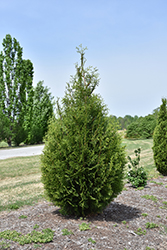Fri & Sat 8am - 8pm
Sun 8am - 7pm
Anytown, USA 12345
fax: 261.787.0463
e-mail: info@successgc.com


Plant Finder

Sugar And Spice™ Arborvitae
Thuja plicata 'Derakt'
Height: 12 feet
Spread: 4 feet
Sunlight:
![]()
![]()
Hardiness Zone: 5b
Other Names: Western Arborvitae, Western Red Cedar
Brand: Star Roses and Plants
Description:
A neat, narrow growing, upright evergreen garden shrub with fine textured green foliage on orange-brown stems; doesn't require pruning to maintain its form; very heat tolerant, and a good vertical accent plant for small spaces or mixed borders
Ornamental Features
Sugar And Spice™ Arborvitae is primarily valued in the landscape or garden for its distinctively pyramidal habit of growth. It has attractive dark green evergreen foliage. The scale-like sprays of foliage are highly ornamental and remain dark green throughout the winter. The shaggy antique red bark and coppery-bronze branches are extremely showy and add significant winter interest.
Landscape Attributes
Sugar And Spice™ Arborvitae is a dense evergreen tree with a strong central leader and a distinctive and refined pyramidal form. Its relatively fine texture sets it apart from other landscape plants with less refined foliage.
This is a relatively low maintenance tree. When pruning is necessary, it is recommended to only trim back the new growth of the current season, other than to remove any dieback. Deer don't particularly care for this plant and will usually leave it alone in favor of tastier treats. It has no significant negative characteristics.
Sugar And Spice™ Arborvitae is recommended for the following landscape applications;
- Accent
- Mass Planting
- Hedges/Screening
- General Garden Use
Planting & Growing
Sugar And Spice™ Arborvitae will grow to be about 12 feet tall at maturity, with a spread of 4 feet. It has a low canopy, and is suitable for planting under power lines. It grows at a slow rate, and under ideal conditions can be expected to live for 50 years or more.
This tree does best in full sun to partial shade. It prefers to grow in average to moist conditions, and shouldn't be allowed to dry out. This plant will benefit from an application of bonemeal and/or mycorrhizal fertilizer at the time of planting. It is not particular as to soil type or pH. It is somewhat tolerant of urban pollution, and will benefit from being planted in a relatively sheltered location. Consider applying a thick mulch around the root zone in winter to protect it in exposed locations or colder microclimates. This is a selection of a native North American species.
